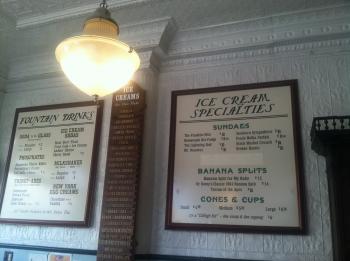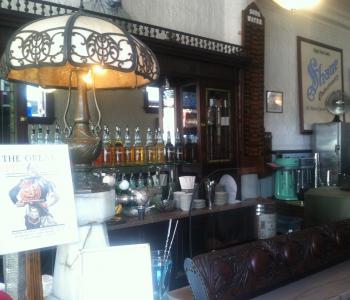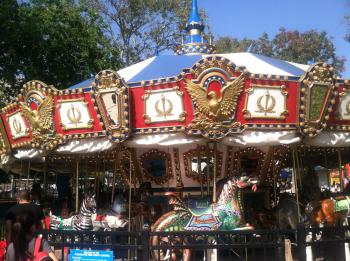Serendip is an independent site partnering with faculty at multiple colleges and universities around the world. Happy exploring!
Critically Playing in the City

This trip into Philly was full of change. This helped me “critically play” because it was different from my normal routine. Mary Flanagan, in the introduction to her book Critical Play, defines play as “central to human and animal life; is generally a voluntary act; offers pleasure in its own right (and by its own rides); is mentally or physically challenging; and is separated from reality” (Flanagan 5). Some aspects of this trip that were different from my normal day include the food, the atmosphere, and the transportation. 
My average day is spent in classes, at a desk studying, or eating the dining halls’ consistent but decent cuisine. The occasional escape from this normalcy is treasured. One very easy way to break this routine is through food. Although Bryn Mawr’s food is delicious, trying new flavors and textures helps interrupt the monotony of the school year. For dietary exploration, I turned to the city of Philadelphia.
This past trip into the city, we walked around, letting serendipity guide us. But we did have a few destinations in mind, one of which was Franklin Fountain. Franklin Fountain is an old-fashioned ice cream parlor sporting homemade ice cream treats, and employees clad in the clothes of yesteryear. Not only was the ice cream delicious, but the complete transportation into an antique soda and ice cream parlor truly fit Flanagan’s description of play being separated from reality.

Another change which helped me to escape reality, and to play critically, was hunting down the Franklin Square carousel. My group’s general plan was to walk around historic Philadelphia; no exact plans were made other than to visit Franklin Fountain. We were reminded of reality when we reached the Visitor Center in Historic Philly, and found it closed due to the government shutdown. After aimlessly and dejectedly walking around for a few minutes, we found a tourist magnet in the form of a tacky and patriotic gift shop, where we found many free brochures offering information on our surroundings. One of the brochures had a picture of a carousel.
Walking four blocks may have been overkill, but we did it. And they were long blocks. We finally saw the spinning horses, and heard the gleeful riders. We watched for long enough to get good pictures and short videos, and then we walked on, letting serendipity again guide us along the streets of Old Philly. We ran into another group from our class, and the groups merged. Together, we embraced the coincidence, and moved on with serendipity and impulse.

Another change from the norm was the mode of transportation. This, however, made it harder for me to enjoy the trip. The extra travel time, and the nauseating rockiness of the one-car train ride led to added stress. I also felt less independent because I had never traveled on that line before. I found myself relying on sources like my group mates and the descriptive YouTube video. I much prefer the septa. This particular separation from my reality did not lead to play.
It was an unconventional trip; going into the city with no real plans, but I think it worked because it was so far out of the realm of the usual. By embracing the spontaneity of just about everything we did, we were able to collectively escape reality, and critically play in the city.
Work cited
Flanagan, Mary. Critical Play: Radical Game Design. Cambridge, MA: MIT, 2009. Print.



Comments
1) what is happening in the
1) what is happening in the first paragraph?
-Ecohn's first paragraph introduces the concept she'll be talking about throughout her essay. She tells the reader that she experienced change, then explained a definition that she'll be using to analyze this change (with Flanagan's "critical play"). She also states a thesis, outlining the general ideas that she'll be talking about.
2) what is happening in you when you read it? what's your experience?
-I am very interested in what she has to say further. The definition she gives from Flanagan pulls me in and makes me wonder what exactly about her own experience was mentally/physically challenging.
3) what "work" is your classmate doing? (what "work" are you doing, in response?)
-Ecohn is providing a smooth introduction to the rest of her essay. She outlines her ideas without giving away too much of her specific topic.
4) how is she "playing"? (how are you "playing," in response?)
She plays the game of introducing and connecting to a new idea without yet explaining how the two things will further connect.
In ecohn’s first paragraph,
In ecohn’s first paragraph, she defines her trip as ‘critically play’ and provides her reason: because this trip was different from the normal routine. She gives three main changes in the trip: the food, atmosphere and transportation, which remind me that in the paragraphs below, she will talk about those three aspects one by one. I think her first paragraph directly introducing the entire paper and in the first sentence, she refers to the ‘change’, which attracts me to continue. She quotes the definition of play by Flanagan and I think maybe she will compare her experience and the definition to make sure if her experience is a play or critical play.